Good vibrations in southern India
Sublime temples and divine interactions on a tour of southern India.
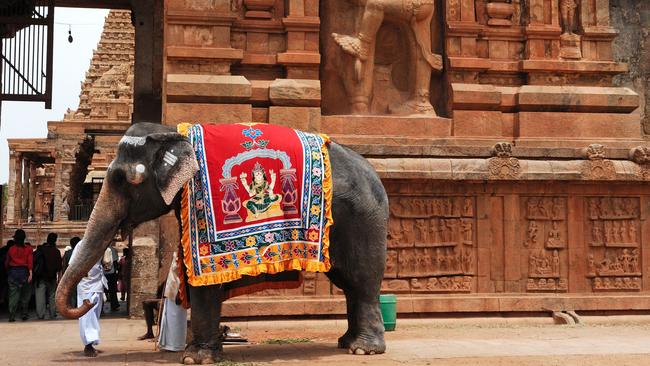
Dressed like a vagabond but eloquent as a prince, guide Raja is an enthusiastic tutor in all things temple-related. “This is excellent, nice, divine! One of the greatest temples in India,” he exclaims as his eyes flutter closed in sublime contemplation of the dusky-pink sandstone glory of Brihadishvara.
South India’s most magnificent temple complex, built in the 10th century during the Chola kingdom — a renaissance period for Indian architecture and art — finally achieved World Heritage status 1000 years later, in 1987.
It’s not only the exquisite architecture — all those towering temples carved intricately with gods and creatures, columns and corbels — that’s remarkable. This has also been a place of worship; “an inseparable part of life of the people”, according to the UNESCO citation, for a millennium. It remains a vibrant and powerful part of life in the central Tamil Nadu city of Thanjavur, as I discover when Raja leads us into the sanctum sanctorum.
“When you enter the temple you will feel a vibration, such a wonderful vibration inside. You will maximum enjoy. Welcome!” he says.
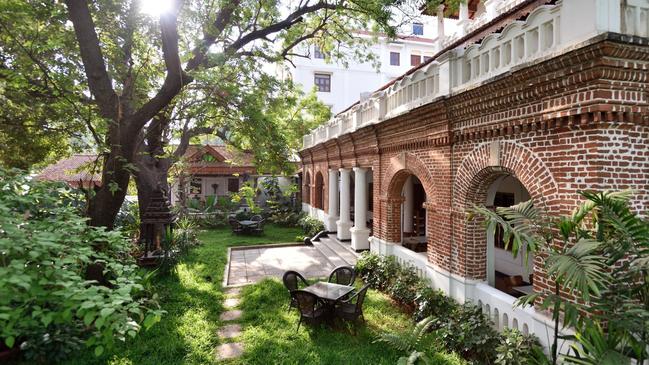
He strikes up a chant as we enter; Indian pilgrims join in around us. Hindus come here to seek Shiva’s divine intervention in all manner of life matters, from health and education to love and money. But no matter how materialistic the human intentions, the experience of being here is seriously spiritual. None of us can put it into words but afterwards we’re all eager to mark the occasion by having the ever-obliging Raja tie ritual threads around our wrists.
After the chanting episode we gain a small entourage of young Indians visiting from Vellore who are as amused and captivated by Raja’s commentary as we are. His enthusiasm is all the more remarkable given he has been doing this for 40 years.
Now 65, “still I am as young,” he assures me. He wears a rudraksha seed, a symbol of Shiva, around his neck to protect against heart attacks and “sugar problems”.
When I ask for his family name he replies: “First name, second name, third name — all Raja!” (The king who built the main Brihadishvara temple circa 1003-1010 was also Raja Raja, so this all makes sense in a very Indian way.) At one point our Raja declares that Chola architecture is one of the world’s five great architectural endowments alongside Egyptian, Greek, Roman and Mayan. “OK? Compris? Capisce? Andiamo!”
He leads us to the far western end of the complex to view the 60m high sanctum tower or vimana, glowing ember-red in the waning sun. “This is the best photographed view,” he cries. “Muy bonito! Bellissimo! Wunderbar!”
Thanks to Raja I will never forget the temples of Thanjavur. A great guide has that power — to make you remember forever.
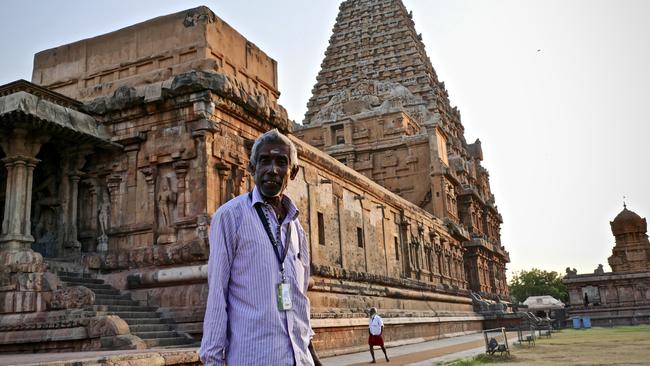
He is a brief but central character of an 11-day tailored tour through southern India with Adventure World Travel, visiting Chennai, Hyderabad, Kerala and Coorg. And Thanjavur, which is known mostly for its temples but also, increasingly, for a boutique luxury hotel called Svatma.
Svatma is a self-styled heritage residence of 34 rooms that celebrates the music, dance and art of once-important, now rather dusty and neglected Thanjavur. It has seven heritage suites in a colonial building originally built for a British trader. Another 27 rooms are housed in a more modern, low-rise tower, the highlight of which is a rooftop bar fashioned from a 200-year-old porch from the neighbouring Chettinad region.
The terrace affords panoramic views over the plains of the Cauvery River delta in central Tamil Nadu.
Nightly cultural performances — chamber recitals of Carnatic music (newly popular thanks to TV show Indian Idol), Vedic chanting, Bharatanatyam dance in praise of Lord Shiva, Hinduism’s “cosmic dancer” — add depth to the guest experience, as does the indigenous architecture of handmade bricks, custom art deco tiles from Chettinad, mismatched chairs and tables and fantastic Burmese teak pillars.
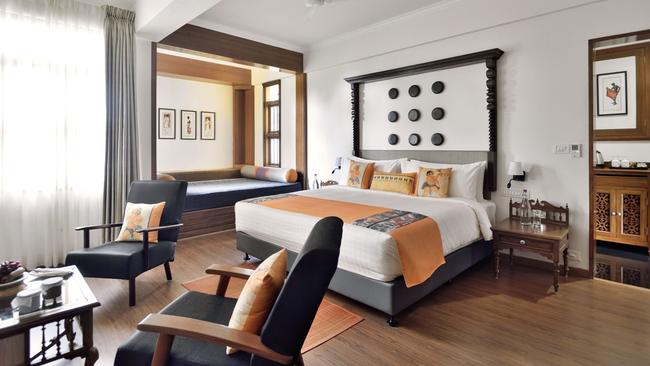
Almost every aspect of Svatma is from the Thanjavur region, but especially the cuisine. The fertile plains surrounding the hotel are known as the rice bowl of South India; the hotel’s Relais & Chateaux-endorsed kitchen has no trouble sourcing local ingredients.
Evening menus tend to be degustations to best showcase the bounty of Tamil Nadu. The food is vegetarian but this is not an issue given Indian is the world’s foremost vegetarian cuisine. The chefs do a fantastic young jackfruit curry, serve beer snacks of sun-dried cluster beans soaked in spiced buttermilk then fried (madly addictive), lemon rasam soup, and halva enriched with jaggery and ghee. The food is nourishing beyond my wildest imaginings. And the wines, while all Indian, are not bad. The Sula chenin blanc is especially quenching.
There is morning yoga, prayer rituals — the priest comes every day — and a pool, gardens and terraces where guests can revel in the Svatma oasis. There is also a spa unlike anything I’ve experienced before. Besides the three conventional treatment rooms there is a fourth “sound therapy” room fitted with all sorts of bespoke instruments.
The session starts with a profound gong that courses through my body like a wave and crests under my chin until the third blow, when the wall of sound crashes through my jawbone and floods my brain. It’s a magnificent sensation that convinces me to surrender completely to the power of sound.
There is no touch, only vibration. Therapist Beni Kikon from Nagaland in India’s north-east has me lie on a “sound bed” with an underside of taut musical strings roughly calibrated to the vertebrae of the human spine. As Raja might say, “Such a wonderful vibration inside. You will maximum enjoy.”
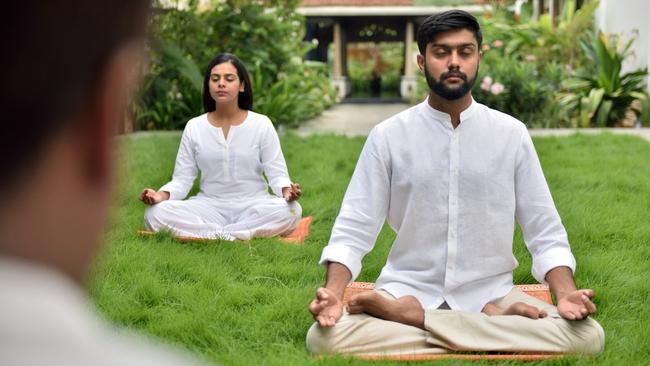
The body is composed mostly of water, Kikon explains, so vibrations travel faster through us than they do through air. She claims they can heal muscle problems.
“This is a new concept,” she concedes.
But it is an enchanting one. Its founders describe it as “a full body listening experience” that promotes “an intuitive opening into the vibrational reality of existence”. I have no idea what that means but can absolutely relate to their other claim that the sound spa is “a magic space of auditory and sonic surprises”. This much is undeniable.
Svatma’s chief executive is Sanjay Umashankar, formerly of Blue Hotel in Sydney’s harbourside Woolloomooloo (his family still lives in Australia). He tells me Svatma is in the process of patenting the sound spa concept. In the meantime, the company is opening a second property, Svatma Ramnivas, as a nine-room centre of holistic wellness offering programs of sound therapy and Siddha yoga.
On the evening after our temple pilgrimage I join Sanjay for cocktails on the rooftop as the sun sets over verdant plains. I mention that I think Raja is a total diamond in the rough and he nods.
“We bought him a fresh set of clothes, and told him he needs to shave when he comes here,” Sanjay chuckles. But to no avail. You can’t change India. Who’d want to?
Kendall Hill was a guest of Adventure World Travel and Svatma, Thanjavur.
-
IN THE KNOW
Adventure World Travel offers customised and set itineraries through South India. The Thanjavur visit was part of an 11-day itinerary from Chennai to Bangalore via Hyderabad, Kerala and Coorg that included all accommodation, internal flights, tours and activities, breakfasts, transfers and sightseeing by minibus. From $7295 a person, twin-share. Singapore Airlines has convenient connections between eight Australian cities and South India, flying into Chennai, Bengaluru, Hyderabad and Kochi via Singapore.
